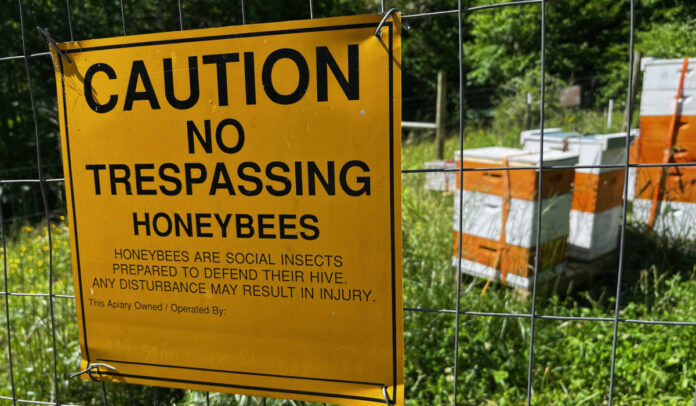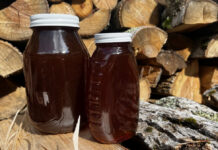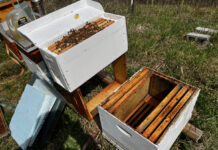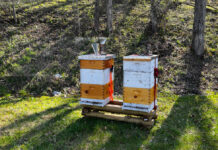
It has been a banner month for our beehives, which are making honey at a rapid rate. I now have five supers on one hive, four supers on another, a third hive with two supers, and two hives with one super each. I don’t expect much of a harvest from the latter hives, at least not this month, but a full super is at least 30 pounds, we should get plenty of honey.
In about two weeks, I’ll be pulling the supers and harvesting the honey. In four years of beekeeping at this location, this is only the second time I will have a harvest in June. Last year was too cold and the first year I didn’t even get my hives until June. I’ll report back in a few weeks with harvest numbers. I am hoping for a big kickoff to a banner year.
After I pull the honey, I will break down these huge hives and taking a peek inside. I’m also going to test them for mites and, if necessary, give them a couple treatments of Oxalic Acid while the honey supers are off. Yes, the new OA is labeled for use while supers are on, but I’d prefer not treat while making honey.
I’d also like to raise some queens from these hives and tap into their genetics as prolific honey producers.
Building an Out Yard
“Out yard” is a term beekeepers use to mean a bee yard or apiary that is not on their home property. I have been searching for an opportunity to build an out yard and have found one.
I have met with the acquaintance who lives at a lower altitude and closer to town, and we picked out a place to put some of my beehives on his property. Yesterday, I delivered hive stands and plan to install two hives on Tuesday, assuming it doesn’t rain. Both hives are splits and have only one or two hive bodies, so they will be easy to move.
I have to decide whether to set up an electric fence to keep out bears. Common sense tells me to do so, but spending $400 is warring with common sense. However, if I look at it as one fence costs me as much as I will make selling 25 to 40 pounds of honey, then it becomes an easier decision as that yard could produce many times that much honey. One day, I might have four, six, or even more hives there, and that is an investment worth protecting. I’ll aim to put up a fence within two weeks.
You can probably tell that I am excited to have an alternate location. Because of the altitude differences, there may be some different sources of pollen and nectar in the out yard. The hives will also have an earlier spring and a longer season. Theoretically, this should mean they produce more honey.
Moving bees from our home bee yard to the out yard will also make my wife happy and keep me under her limit of 10 hives on our property.
Building Sting Resistance
I have finally developed a rather strong resistance to bee stings. When I get stung, I still jump a little and curse, but the pain is fleeting. Best of all, the site doesn’t turn red, swell, or throb when I am lying in bed at night.
When I got stung this weekend, I forgot all about it. Then I was watching YouTube, idly scratching my hand. Why did my thumb itch? That’s when I remember the pesky bee stung me there. Instead of a red swollen lump, there was a small dot.
I have been stung on at least four occasions this year, with two incorporating multiple stings. Each time, the pain and my body’s response has decreased. I hope I maintain this resistance because it is a real boon to a beekeeper!






